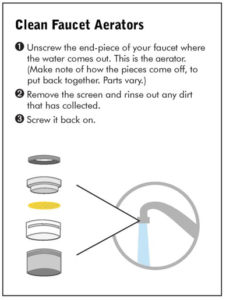KC Water produces high-quality water and monitors it throughout the distribution system. However, once water enters a private plumbing system, the property owner is responsible for maintaining it, as it can affect the taste, odor, and appearance of the water. It is up to every customer to understand and maintain their private plumbing systems and water-using devices.
Use only “cold” water for drinking and cooking: Material can build up in water heaters over time which could result in a lower water quality and possibly introduce contaminants. The EPA recommends avoiding the use of “hot” water for drinking or cooking.
Cleaning Faucet Aerator: Most faucets have aerators attached to the tip which need to be cleaned periodically. This is a thin grate which prevents splashing, reduces faucet noise, and conserves water. Minerals such as calcium and magnesium can build up over time causing a white flaky scale.

Draining Hot Water Tank: Draining your hot water tank annually can help it last longer, perform more efficiently, and save you money. Draining removes sediment that can build up over time from minerals in the water and sand and grit from water lines. This sediment can reduce your water heater’s capacity and efficiency, plug the drain, and make maintenance more difficult.
Filtration in the Home: Make sure to change any type of water filter according to the manufacturer’s instructions. If you don’t, the filter can become a breeding ground for bacteria growth and reduce water quality. Filters aren’t just in water systems; they can also be found in fridges, coffee makers, and other kitchen appliances. If you’re not sure if an appliance has a water filter, check the manual.
Water treatment systems that treat all the water coming into your home or just at specific points have the potential to alter the chemistry and quality of water in your home. It’s important to use the correct settings and keep up with maintenance. Check with the manufacturer, a plumber, or a water expert for the right settings and maintenance schedule.
Flushing Pipes in the Home: Sometimes water can sit in pipes and start to smell or taste bad. To fix this, run water from the problem faucet for at least 2 minutes or until it gets cold, especially after not using it for a while.
- For cloudy water, flush from a high point in your home. This usually happens because of tiny air bubbles.
- For rusty water, flush from a low point in your home. Rusty water can come from your pipes/fixtures, occur when nearby water mains are being worked on, or when there are changes in water flow.
Drink from Glass Container: Some plastic or metal containers can add extra tastes or odors to the water. Glass is least likely to affect the flavor.
Chill the Water: Cool water has less flavor than room temperature water. Fill a closed glass container from the tap, place it in the refrigerator, and allow it to cool before drinking.
Clean the Drains: Drains can collect build-up, become clogged, or smell bad, which might make it seem like the water itself has an odor. To check if the drain is the problem, fill a glass of cold water and move it to another room. If the water doesn’t have an odor away from the sink, then the drain may be causing the smell or taste.